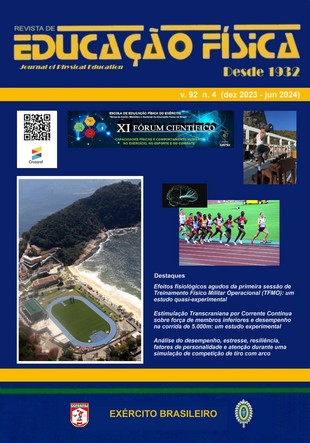Resumo
Introdução: As sessões de Treinamento Físico Militar Operacional (TFMO) consistem em exercícios projetados para desenvolver o estado físico de prontidão operacional das tropas da Força de Prontidão do Exército Brasileiro.
Objetivo: Examinar os efeitos fisiológicos de uma sessão de TFMO sobre a frequência cardíaca (FC) e o lactato sanguíneo.
Métodos: Estudo do tipo quasi-experimental, com amostra por conveniência, para o qual foram convidados a participar 15 soldados em uma unidade militar no Rio de Janeiro (Bateria Estácio de Sá). Foram coletados lactato sanguíneo antes e após a sessão e a FC foi medida nas fases neuromuscular e tarefa operacional. Foi aplicado o Teste de Shapiro-Wilk para avaliar a normalidade na distribuição dos dados. Para avaliar as diferenças entre as medidas pré e pós-intervenção, utilizou-se o teste t de Student pareado e não pareado.
Resultados: Participaram do estudo 15 militares. Os valores de lactato pré e pós sessão de TFMO foram significativamente diferentes (p=0,024), sendo que o lactato pré (média de 2,58±0,27 mmol/L) foi menor que o lactato pós (média de 3,93±1,22 mmol/L). Houve diferença significativa na comparação das médias da FC na fase neuromuscular em circuito com a fase tarefa operacional (p<0,001), sendo que a média da FC na fase neuromuscular foi menor do que na fase tarefa operacional.
Conclusão: A primeira sessão de treinamento físico militar operacional gerou alterações fisiológicas nos militares em relação à concentração de lactato e à frequência cardíaca. Os resultados foram discutidos.
Referências
Santtila M, Kyröläinen H, Vasankari T, Tiainen S, Palvalin K, Häkkinen A, et al. Physical Fitness Profiles in Young Finnish Men during the Years 1975-2004. Medicine & Science in Sports & Exercise. 2006;38(11): 1990–1994. https://doi.org/10.1249/01.mss.0000232023.28984.78.
Knapik JJ, Sharp MA, Steelman RA. Secular Trends in the Physical Fitness of United States Army Recruits on Entry to Service, 1975–2013. Journal of Strength and Conditioning Research. 2017;31(7): 2030–2052. https://doi.org/10.1519/JSC.0000000000001928.
Sharp. A Database of Physically Demanding Tasks Performed by U.S. Army Soldiers. https://apps.dtic.mil/sti/citations/ADA338922
Hauschild VD, DeGroot DW, Hall SM, Grier TL, Deaver KD, Hauret KG, et al. Fitness tests and occupational tasks of military interest: a systematic review of correlations. Occupational and Environmental Medicine. 2017;74(2): 144–153. https://doi.org/10.1136/oemed-2016-103684.
Kyröläinen H, Pihlainen K, Vaara JP, Ojanen T, Santtila M. Optimising training adaptations and performance in military environment. Journal of Science and Medicine in Sport. 2018;21(11): 1131–1138. https://doi.org/10.1016/j.jsams.2017.11.019.
Instituto de Pesquisa da Capacitação Física do Exército. Teste Físico Operacional (TFO). Revista de Educação Física / Journal of Physical Education. 2021;90(2): S6–S7.
Friedl KE, Knapik JJ, Häkkinen K, Baumgartner N, Groeller H, Taylor NAS, et al. Perspectives on Aerobic and Strength Influences on Military Physical Readiness: Report of an International Military Physiology Roundtable. Journal of Strength and Conditioning Research. 2015;29(Supplement 11): S10–S23. https://doi.org/10.1519/JSC.0000000000001025.
Gibala MJ, Gagnon PJ, Nindl BC. Military Applicability of Interval Training for Health and Performance. Journal of Strength and Conditioning Research. 2015;29(Supplement 11): S40–S45. https://doi.org/10.1519/JSC.0000000000001119.
Gist NH, Freese EC, Ryan TE, Cureton KJ. Effects of Low-Volume, High-Intensity Whole-Body Calisthenics on Army ROTC Cadets. Military Medicine. 2015;180(5): 492–498. https://doi.org/10.7205/MILMED-D-14-00277.
Marín-Pagán C, Blazevich AJ, Chung LH, Romero-Arenas S, Freitas TT, Alcaraz PE. Acute Physiological Responses to High-Intensity Resistance Circuit Training vs. Traditional Strength Training in Soccer Players. Biology. 2020;9(11): 383. https://doi.org/10.3390/biology9110383.
Márquez G, Romero‐Arenas S, Marín‐Pagán C, Vera‐Ibañez A, FernáNdez Del Olmo M, Taube W. Peripheral and central fatigue after high intensity resistance circuit training. Muscle & Nerve. 2017;56(1): 152–159. https://doi.org/10.1002/mus.25460.
Dougherty JJ. The anatomical “core”: a definition and functional classification. Osteopathic Family Physician. 2011;3(6): 239–245. https://doi.org/10.1016/j.osfp.2011.07.001.
Aquino PAA. Exercício físico para promoção da saúde durante o período gestacional: recomendações e cuidados. [Dissertação de Mestrado Profissional] [Londrina]: Unopar; 2023. https://repositorio.pgsscogna.com.br/bitstream/123456789/58550/1/Produto%20Tecnico%20Defesa%20Pos%20Banca.pdf [Accessed 27th May 2024].
Fidje Sports Equipment. Quais são as diferenças entre um Slam Ball, Wall Ball e Medicine Ball? - Fidje. https://www.fidje.com.br/quais-sao-as-diferencas-entre-um-slam-ball-wall-ball-e-medicine-ball/ [Accessed 25th April 2024].
Brito A., Fernandes R. , Carvalho H. , Brito J., Muñoz A., Soto A., & Miarka B. Acute effect of high-intensity functional training (HIFT) using a benchmark on cognition and physiological parameters according to the competitive level. Journal of Physical Education and Sport. 23(6):1432-1440. https://doi.org/10.7752/jpes.2023.06175.
Tibana RA, Manuel Frade De Sousa N, Prestes J, Da Cunha Nascimento D, Ernesto C, Falk Neto J, et al. Is Perceived Exertion a Useful Indicator of the Metabolic and Cardiovascular Responses to a Metabolic Conditioning Session of Functional Fitness? Sports. 2019;7(7): 161. https://doi.org/10.3390/sports7070161.
Tibana R, De Sousa N, Prestes J, Voltarelli F. Lactate, Heart Rate and Rating of Perceived Exertion Responses to Shorter and Longer Duration CrossFit® Training Sessions. Journal of Functional Morphology and Kinesiology. 2018;3(4): 60. https://doi.org/10.3390/jfmk3040060.
Santos DAT, Morais NS, Viana RB, Costa GCT, Andrade MS, Vancini RL, et al. Comparison of physiological and psychobiological acute responses between high intensity functional training and high intensity continuous training. Sports Medicine and Health Science. 2023; https://doi.org/10.1016/j.smhs.2023.10.006.
de Diego-Moreno M, Álvarez-Salvago F, Martínez-Amat A, Boquete-Pumar C, Orihuela-Espejo A, Aibar-Almazán A, et al. Acute Effects of High-Intensity Functional Training and Moderate-Intensity Continuous Training on Cognitive Functions in Young Adults. International Journal of Environmental Research and Public Health. 2022;19(17): 10608. https://doi.org/10.3390/ijerph191710608.
McArdle WD, Katch FI, Katch VL. Fisiologia do Exercício. Nutrição, Energia e Desempenho Humano.. 7a edição. Rio de Janeiro: Guanabara Koogan; 2011.
Almeida MB de. Heart rate and exercise: An evidence-based interpretation. Revista Brasileira de Cineantropometria e Desempenho Humano. 2007;9(2): 196–202. https://doi.org/10.1590/%x.
Burke ER, [ed.]. Precision Heart Rate Training.. 1st edition. Champaign, Il: Human Kinetics; 1998.
Moreno MR, Rodas KA, Bloodgood AM, Dawes JJ, Dulla JM, Orr RM, et al. The Influence of Aerobic Fitness on Heart Rate Responses of Custody Assistant Recruits during Circuit Training Sessions. International Journal of Environmental Research and Public Health. 2020;17(21): 8177. https://doi.org/10.3390/ijerph17218177.
Mainenti M, Oliveira L, Godinho S. Treinamento físico do militar combatente: discutindo funcionalidade e especificidade. In: Celestino S, Cunha R. Ciência para a saúde, a operacionalidade e o desporto militar. Curitiba: Editora CRV, 2023. p.147-164.

Este trabalho está licenciado sob uma licença Creative Commons Attribution 4.0 International License.
Copyright (c) 2024 Revista de Educação Física / Journal of Physical Education
